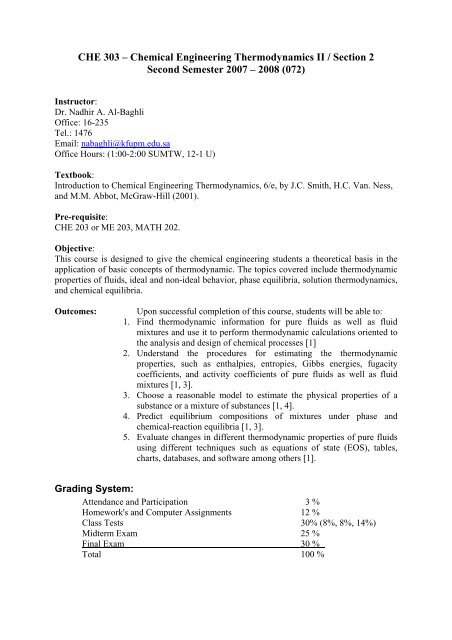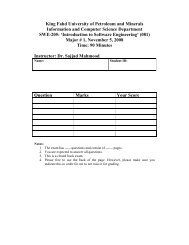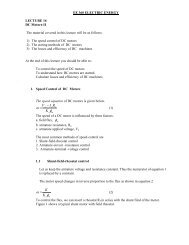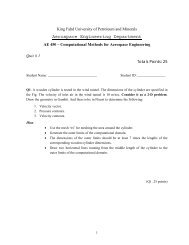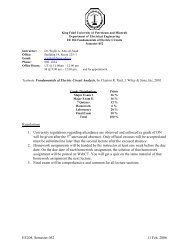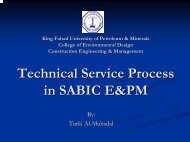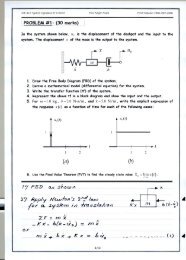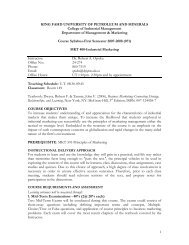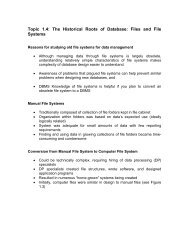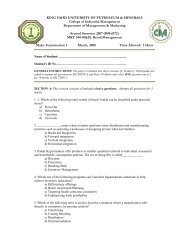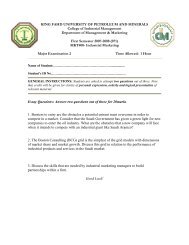CHE 303 â Chemical Engineering Thermodynamics II / Section 2
CHE 303 â Chemical Engineering Thermodynamics II / Section 2
CHE 303 â Chemical Engineering Thermodynamics II / Section 2
You also want an ePaper? Increase the reach of your titles
YUMPU automatically turns print PDFs into web optimized ePapers that Google loves.
<strong>CHE</strong> <strong>303</strong> – <strong>Chemical</strong> <strong>Engineering</strong> <strong>Thermodynamics</strong> <strong>II</strong> / <strong>Section</strong> 2<br />
Second Semester 2007 – 2008 (072)<br />
Instructor:<br />
Dr. Nadhir A. Al-Baghli<br />
Office: 16-235<br />
Tel.: 1476<br />
Email: nabaghli@kfupm.edu.sa<br />
Office Hours: (1:00-2:00 SUMTW, 12-1 U)<br />
Textbook:<br />
Introduction to <strong>Chemical</strong> <strong>Engineering</strong> <strong>Thermodynamics</strong>, 6/e, by J.C. Smith, H.C. Van. Ness,<br />
and M.M. Abbot, McGraw-Hill (2001).<br />
Pre-requisite:<br />
<strong>CHE</strong> 203 or ME 203, MATH 202.<br />
Objective:<br />
This course is designed to give the chemical engineering students a theoretical basis in the<br />
application of basic concepts of thermodynamic. The topics covered include thermodynamic<br />
properties of fluids, ideal and non-ideal behavior, phase equilibria, solution thermodynamics,<br />
and chemical equilibria.<br />
Outcomes:<br />
Upon successful completion of this course, students will be able to:<br />
1. Find thermodynamic information for pure fluids as well as fluid<br />
mixtures and use it to perform thermodynamic calculations oriented to<br />
the analysis and design of chemical processes [1]<br />
2. Understand the procedures for estimating the thermodynamic<br />
properties, such as enthalpies, entropies, Gibbs energies, fugacity<br />
coefficients, and activity coefficients of pure fluids as well as fluid<br />
mixtures [1, 3].<br />
3. Choose a reasonable model to estimate the physical properties of a<br />
substance or a mixture of substances [1, 4].<br />
4. Predict equilibrium compositions of mixtures under phase and<br />
chemical-reaction equilibria [1, 3].<br />
5. Evaluate changes in different thermodynamic properties of pure fluids<br />
using different techniques such as equations of state (EOS), tables,<br />
charts, databases, and software among others [1].<br />
Grading System:<br />
Attendance and Participation 3 %<br />
Homework's and Computer Assignments 12 %<br />
Class Tests 30% (8%, 8%, 14%)<br />
Midterm Exam 25 %<br />
Final Exam<br />
30 %_<br />
Total 100 %
Course Outline:<br />
Topic Chapter Lectures<br />
Review 1 st and 2 nd Laws of <strong>Thermodynamics</strong> 1 to 5 4<br />
Applications of <strong>Thermodynamics</strong> to Flow Processes 7 3<br />
Class Test I (Mon.: March 3, 2008)<br />
Production of Power from Heat 8 3<br />
<strong>Thermodynamics</strong> Properties of Fluids 6 7<br />
Class Test <strong>II</strong> (Mon.: March 24, 2008)<br />
Introduction Vapor/Liquid Equilibrium 10 5<br />
Midterm Exam (Mon: April 24, 2008)<br />
Solution <strong>Thermodynamics</strong>: Theory 11 7<br />
Solution <strong>Thermodynamics</strong>: Applications 12 5<br />
Class Test <strong>II</strong>I (Mon.: May 12, 2008)<br />
<strong>Chemical</strong>-Reaction Equilibria 13 6


